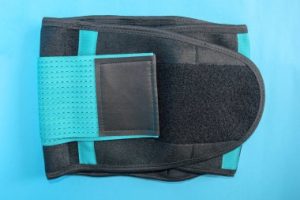
Can You Exercise With Waist Trainer (6 Helpful Facts)
Can you exercise with waist trainer? This question dances at the intersection of fitness trends and wellness wisdom, capturing the curiosity of many who are eager to sculpt their silhouettes while sweating it out. Waist trainers, those snug corsets promising cinched waists and enhanced curves, have surged in popularity, endorsed by celebrities and fitness influencers alike.
They tout a quick fix for a coveted hourglass figure, but can they really complement a rigorous workout routine? Imagine transforming your waistline as you lift, run, or stretch—sounds like a dream, right? Yet, beneath the allure of instant results lies a complex web of potential benefits and risks that every fitness enthusiast must untangle. Let’s delve into the intriguing world of waist trainers and exercise, exploring whether this trendy tool is a friend or foe in your fitness journey.

Can You Exercise With Waist Trainer
Yes, you can exercise with a waist trainer, but it’s crucial to do so safely and with the right expectations. Waist trainers are popular for their ability to give an instant hourglass figure and are often worn during workouts to enhance sweat and potentially aid in weight loss.
What Is Waist Trainer
Waist trainers, often marketed as a shortcut to achieving an hourglass figure, are garments designed to cinch the waist and compress the midsection. While they have gained popularity in recent years, especially in the realm of fitness and fashion, their effectiveness and safety remain subjects of debate. Proponents claim that waist trainers can help sculpt the waist, provide back support, and even aid in weight loss by increasing perspiration in the abdominal area during workouts.
However, skeptics argue that any temporary slimming effect is merely due to compression and redistribution of fat, rather than actual fat loss. Moreover, prolonged use of waist trainers can potentially lead to discomfort, restricted breathing, and even damage to internal organs by compressing them. It’s essential for individuals considering waist trainers to prioritize their health and consult with a medical professional before incorporating them into their routine. As with any body modification tool, moderation and caution are key, and sustainable results are best achieved through a combination of healthy eating, regular exercise, and a balanced lifestyle.
Benefits and Risks of Exercising with a Waist Trainer
Exercising with a waist trainer can help you sweat more, which may give the appearance of temporary weight loss due to water loss. Many people use waist trainers during cardio exercises like running, cycling, and aerobics, believing it helps in burning fat faster. Additionally, the compression can provide some back support, which might be beneficial during certain strength training routines.
However, there are significant risks associated with using a waist trainer while exercising. The tight compression can restrict breathing, reduce core muscle engagement, and potentially cause dizziness or fainting. Long-term use can also lead to muscle weakness and dependence on the waist trainer for posture support. It is crucial to listen to your body and ensure the waist trainer is not too tight, allowing for full, deep breaths and adequate movement.
Choosing the Right Waist Trainer for Exercise
Selecting the appropriate waist trainer for exercise is essential to maximize benefits and minimize risks. Opt for a waist trainer made of flexible, breathable materials to ensure comfort and adequate airflow during intense workouts. Look for adjustable models that allow you to control the level of compression.
Many fitness enthusiasts recommend latex waist trainers with hook-and-eye closures or Velcro straps for a customizable fit. Avoid overly stiff or rigid trainers that can significantly restrict movement and breathing. It’s also wise to gradually incorporate the waist trainer into your exercise routine, starting with short sessions and gradually increasing the duration as your body adjusts.
Tips for Safe Workouts with a Waist Trainer
When incorporating a waist trainer into your workout regimen, it’s important to follow safety guidelines to prevent injury. Start with low-intensity exercises to see how your body responds to the added compression. Always warm up properly before putting on the waist trainer, and stay hydrated to offset the increased sweating.
Pay close attention to your breathing; if you feel short of breath or dizzy, stop the exercise and remove the waist trainer immediately. Avoid high-intensity or high-impact exercises that require extensive core engagement, such as heavy lifting or intense HIIT workouts, as these can be particularly risky. Instead, focus on moderate cardio and light strength training.
Purpose of Using Waist Trainers During Exercise
Aesthetic Goals
The purpose of using waist trainers during exercise spans various dimensions, primarily catering to aesthetic goals while also promoting the perception of an immediate visual effect of a smaller waist. Waist trainers have gained popularity for their ability to cinch the midsection, creating a contoured silhouette that many individuals aspire to achieve. This aesthetic appeal is often a driving force behind their usage, especially in fitness routines where individuals seek to enhance their appearance while working out.
The immediate visual effect of a smaller waist can boost confidence and motivation during exercise sessions, providing a tangible marker of progress and reinforcing the belief that one is on the right track toward their fitness goals. However, beyond the immediate visual impact, there are claims of long-term body shaping attributed to consistent use of waist trainers during exercise.
Proponents argue that the compression provided by waist trainers can assist in waist slimming over time by promoting perspiration and heat retention in the midsection, theoretically aiding in the reduction of fat deposits and water retention. Additionally, some believe that waist trainers may help improve posture during workouts, potentially leading to muscle engagement and toning in the abdominal area. While these claims are debated and not universally supported by scientific evidence, they contribute to the allure of waist trainers as a tool for achieving both short-term and long-term body shaping goals during exercise routines.
Perceived Benefits
Waist trainers have gained popularity as workout accessories, often touted for their potential benefits during exercise routines. One of the primary purposes of using waist trainers during exercise is to enhance the intensity of workouts by increasing sweating and promoting water loss. This heightened perspiration is believed to lead to temporary weight loss and slimming effects, though it’s important to note that any weight lost is predominantly water weight and not fat.
Additionally, waist trainers are often praised for their ability to provide enhanced posture support. By cinching around the midsection, they encourage the wearer to maintain a straighter posture during physical activities, which can alleviate strain on the back and promote better spinal alignment.
Moreover, waist trainers can aid in core stabilization by applying gentle pressure to the abdominal area, prompting the muscles to engage more effectively. This can contribute to improved core strength and stability over time, which is beneficial for various exercises and overall physical health. However, it’s crucial to approach the use of waist trainers with caution and moderation, as excessive compression can restrict breathing and blood flow, leading to potential health risks. Additionally, it’s essential to prioritize sustainable lifestyle habits, such as regular exercise and a balanced diet, for long-term health and fitness goals.
Psychological Factors
Psychological factors play a pivotal role in shaping our experiences, especially in the realm of fitness and exercise. Motivation serves as a driving force behind our actions, influencing our commitment to fitness routines and the methods we employ to achieve our goals. In this context, the placebo effect emerges as a fascinating phenomenon, where belief in the efficacy of a particular tool or technique can yield tangible improvements, even if the intervention itself lacks empirical validation. This is particularly evident in the case of using waist trainers during workouts.
Despite the lack of concrete evidence supporting their efficacy in enhancing fitness outcomes, individuals often report increased confidence and perceived benefits when incorporating waist trainers into their exercise regimens. This boost in confidence can lead to a positive feedback loop, where heightened belief in the effectiveness of the waist trainer enhances motivation and encourages individuals to push harder during workouts, thereby potentially improving performance and results. Thus, while the physical effects of waist trainers may be debatable, the psychological impact cannot be overlooked, underscoring the intricate interplay between mindset, motivation, and perceived performance enhancements in the realm of fitness.

The Pros of Exercising with a Waist Trainer
Increased Thermogenic Effect
One significant advantage of exercising with a waist trainer is the potential for an increased thermogenic effect. The compression provided by the waist trainer can generate heat in the abdominal area, promoting sweat production and raising the body’s core temperature. This rise in temperature may enhance calorie expenditure during exercise, potentially aiding in weight loss efforts.
Additionally, the increased perspiration can help remove toxins from the body and contribute to a temporary slimming effect. For individuals seeking to maximize their calorie burn and sweat output during workouts, incorporating a waist trainer may offer an added boost to their fitness regimen. However, it’s crucial to approach this method with caution and prioritize safety, ensuring proper hydration and monitoring for signs of discomfort or overexertion.
Improved Posture and Stability
The compression provided by the waist trainer encourages the wearer to maintain a straighter posture during workouts, reducing the risk of slouching or arching the back excessively. This improved alignment not only enhances the aesthetic appeal of the physique but also supports the spine, reducing the likelihood of developing back pain or discomfort.
Additionally, the added stability around the midsection can aid in maintaining balance during various exercises, particularly those that involve twisting or bending movements. By promoting better posture and stability, waist trainers can contribute to overall biomechanical efficiency and reduce the risk of injury, making them a valuable tool for individuals seeking to optimize their workout routines.
Enhanced Core Activation
Exercising with a waist trainer can enhance core activation by providing constant compression around the midsection, prompting the muscles in the abdominal area to engage more consistently. This heightened engagement can lead to improved muscle tone and potentially faster results in achieving a slimmer waistline. The waist trainer acts as a reminder to maintain proper posture and core engagement, which can be particularly beneficial during exercises that target the abdominal muscles, such as planks, crunches, and leg raises.
By keeping the core muscles activated throughout the workout, individuals may experience increased strength and stability, which can contribute to better overall performance and effectiveness of their fitness routines. However, it’s crucial to balance the use of a waist trainer with mindful practice to avoid over-reliance and ensure that core strengthening is achieved through natural muscle use.
Psychological Boost
Exercising with a waist trainer can offer a significant psychological boost, which can be a powerful motivator for many individuals. The immediate visual effect of a cinched waist can enhance body image and self-confidence, providing an instant sense of achievement and progress toward fitness goals. This visible transformation, even if temporary, can motivate individuals to maintain their exercise routine and make healthier lifestyle choices.
Additionally, the act of wearing a waist trainer can serve as a constant physical reminder of one’s fitness ambitions, reinforcing the commitment to stay active and focused. The combination of improved posture and a more defined silhouette can lead to a positive feedback loop, where increased confidence encourages more frequent and enthusiastic participation in physical activities. Overall, the psychological benefits of wearing a waist trainer while exercising can help sustain motivation and dedication, which are crucial components of long-term fitness success.

The Cons of Exercising with a Waist Trainer
Restricted Breathing
Exercising with a waist trainer can significantly restrict breathing, posing a serious concern for those who use these garments during physical activity. Waist trainers are designed to tightly compress the midsection, which can limit the expansion of the diaphragm and lungs, making deep breaths difficult. This restriction can lead to reduced oxygen intake, causing dizziness, shortness of breath, and fatigue more quickly than usual. In extreme cases, the limited airflow can compromise cardiovascular performance and endurance, impeding the effectiveness of the workout.
Additionally, the strain on the respiratory system can increase the risk of hyperventilation and may exacerbate pre-existing respiratory conditions such as asthma. Therefore, the restriction of natural breathing patterns is a significant downside to consider when contemplating the use of a waist trainer during exercise.
Potential for Discomfort and Chafing
Exercising with a waist trainer can lead to significant discomfort and chafing, which are among the most commonly reported drawbacks. The tight compression needed to cinch the waist can cause friction against the skin, especially during physical activities that involve movement and sweating. This friction can result in skin irritation, redness, and painful chafing, particularly around the edges of the waist trainer.
Additionally, the restrictive nature of the garment can limit the range of motion, making certain exercises uncomfortable or even impractical. Over time, this discomfort can detract from the overall exercise experience, reducing motivation and potentially leading to inconsistent workout routines. Moreover, wearing a waist trainer that is too tight can exacerbate these issues, causing more severe skin damage and increasing the risk of bruising or pinching. To mitigate these problems, it’s crucial to ensure a proper fit, choose high-quality materials, and limit the duration of waist trainer use during workouts.
Dependence and Risk of Injury
Exercising with a waist trainer carries significant risks of dependence and injury. The tight compression of the waist trainer can restrict the natural range of motion, leading to improper form and technique during workouts. This can increase the risk of muscle strain, joint issues, and long-term musculoskeletal problems. Additionally, the constant use of a waist trainer can lead to reliance on the garment for posture support and core engagement, potentially weakening the abdominal and back muscles over time.
This dependence may diminish the body’s natural ability to maintain proper posture and core stability without external support, making it more susceptible to injury when the waist trainer is not worn. Furthermore, the restrictive nature of waist trainers can impede proper breathing, reducing oxygen intake and overall workout effectiveness, which can also contribute to fatigue and dizziness. These factors underscore the importance of caution and awareness when considering the use of waist trainers during exercise.
No Substantive Evidence for Long-term Benefits
One significant drawback of exercising with a waist trainer is the lack of substantive evidence supporting its long-term benefits. While these garments might provide temporary waist compression and a perceived slimming effect, scientific studies have not demonstrated that they contribute to lasting changes in body shape or fat reduction. The apparent immediate results are largely due to the redistribution of body fat and fluids rather than actual fat loss.
Furthermore, relying on a waist trainer can detract from the development of proper core muscles and might lead to muscle atrophy due to the external support. The absence of rigorous, peer-reviewed research validating the efficacy of waist trainers for sustainable fitness and body transformation underscores the need for caution. Therefore, individuals should be wary of claims that promise quick fixes and instead focus on proven methods such as balanced nutrition, regular exercise, and overall healthy lifestyle choices for long-term results.

Safety Guidelines for Exercising with a Waist Trainer
Consultation with a Medical Professional
Before starting an exercise regimen with a waist trainer, it’s crucial to consult with a medical professional. This ensures that the waist trainer is appropriate for your body type and health condition, particularly if you have pre-existing conditions such as respiratory or circulatory issues. A healthcare provider can offer personalized advice on the duration and intensity of use to minimize potential risks, such as restricted breathing or internal organ pressure. Medical consultation can also help you understand the signs of overuse or misuse, promoting a safer and more effective workout experience. Prioritizing professional guidance helps to balance the aesthetic goals of waist training with overall physical well-being.
Gradual Progression and Monitoring
When incorporating a waist trainer into your exercise routine, it is crucial to adhere to safety guidelines to prevent injury and ensure effective results. Begin with gradual progression, allowing your body to adapt to the added compression. Start by wearing the waist trainer for short periods, progressively increasing the duration as your comfort level improves.
Monitoring is essential; pay close attention to your body’s signals, including breathing difficulty, pain, or excessive pressure. Always ensure the waist trainer fits properly, avoiding overly tight settings that can restrict movement or circulation. Combining these practices with regular check-ins with a fitness professional can help maintain safety and promote a healthier, more effective workout experience.
Alternative Methods For Achieving Fitness Goals
Core Strengthening Exercises
Strengthening your core is vital for overall fitness as it stabilizes your body and improves posture, balance, and performance in daily activities and sports. Effective core exercises like planks, crunches, and leg raises engage multiple muscle groups, enhancing core stability and strength.
Balanced Diet and Hydration
Nutrition plays a crucial role in weight management, providing essential nutrients for energy, muscle repair, and metabolism. Staying hydrated is key for optimal performance and recovery during workouts, aiding digestion and regulating body temperature.
High-Intensity Interval Training (HIIT)
HIIT is highly effective for fat loss and muscle toning, as it boosts metabolism and promotes calorie burning even after the workout. Sample HIIT routines include alternating between high-intensity exercises like sprints or burpees and short rest periods, maximizing results in minimal time.
Proper Clothing and Equipment
Wearing appropriate workout gear enhances comfort, performance, and safety during exercise, providing support and freedom of movement. Unlike waist trainers, which restrict movement and may impede breathing, proper clothing and equipment allow for natural motion and airflow, optimizing workouts and reducing the risk of injury.
Frequently Asked Questions (FAQ) about Can You Exercise With Waist Trainer
Q. Can you exercise with a waist trainer?
A. Yes, you can exercise with a waist trainer, but it’s important to do so with caution. Waist trainers can provide additional support and help with posture during workouts, but they should not restrict your breathing or movement.
Q. What types of exercises are suitable when wearing a waist trainer?
A. Low to moderate-intensity activities such as walking, stretching, and light strength training are generally suitable when wearing a waist trainer. High-intensity workouts or exercises that require a full range of motion, like running or heavy lifting, may be hindered by a waist trainer.
Q. Are there any risks associated with exercising while wearing a waist trainer?
A. Yes, there are potential risks. These include restricted breathing, reduced core muscle engagement, skin irritation, and discomfort. Over-tightening can lead to more serious issues such as impaired circulation or internal organ pressure.
Q. How tight should a waist trainer be during exercise?
A. A waist trainer should be snug but not too tight. You should be able to breathe deeply and move comfortably. If you feel pain, discomfort, or significant restriction in your breathing or movement, it’s too tight.
Q. How long can I wear a waist trainer while exercising?
A. It’s recommended to start with shorter periods, such as 20-30 minutes, and gradually increase the duration as your body gets accustomed to it. However, it is generally advised not to exceed one hour of wear during exercise to avoid potential health risks.
Q. What should I look for in a waist trainer if I plan to use it during workouts?
A. Choose a waist trainer made of breathable, flexible material that allows for movement. Look for adjustable options to ensure a proper fit, and avoid overly rigid or heavily boned trainers that could restrict your activity.
Q. Can a waist trainer enhance my workout results?
A. While a waist trainer can temporarily alter your waist shape and support your posture, it does not directly contribute to fat loss or muscle gain. Effective workout results come from a combination of consistent exercise, a balanced diet, and healthy lifestyle habits.
Q. Is it better to exercise with or without a waist trainer?
A. This depends on your personal goals and comfort. Some people find that a waist trainer helps them maintain better posture and support during certain exercises. However, others may find it restrictive. Listening to your body and consulting with a fitness professional can help you decide what works best for you.
Q. What precautions should I take when exercising with a waist trainer?
A. Ensure the waist trainer is not too tight, listen to your body’s signals, stay hydrated, and avoid wearing it for excessively long periods. If you experience any discomfort, pain, or difficulty breathing, stop using it immediately and consult a healthcare professional if necessary.
Q. Can beginners use a waist trainer during exercise?
A. Beginners can use a waist trainer, but they should start slowly and monitor their body’s response closely. It’s advisable to get accustomed to exercising without one first and then gradually introduce it to your routine if desired. Always prioritize comfort and safety.
Conclusion
In conclusion, exercising with a waist trainer can offer some temporary aesthetic benefits, such as a more defined waistline, but it also carries significant risks and limitations. While waist trainers may provide a sense of support and improve posture during workouts, they can restrict breathing, reduce core muscle engagement, and potentially lead to long-term health issues like organ compression and weakened abdominal muscles. For sustainable and safe fitness results, it’s recommended to focus on a balanced exercise regimen and healthy diet. Always consult with a healthcare or fitness professional before incorporating a waist trainer into your exercise routine to ensure it aligns with your personal health and fitness goals.